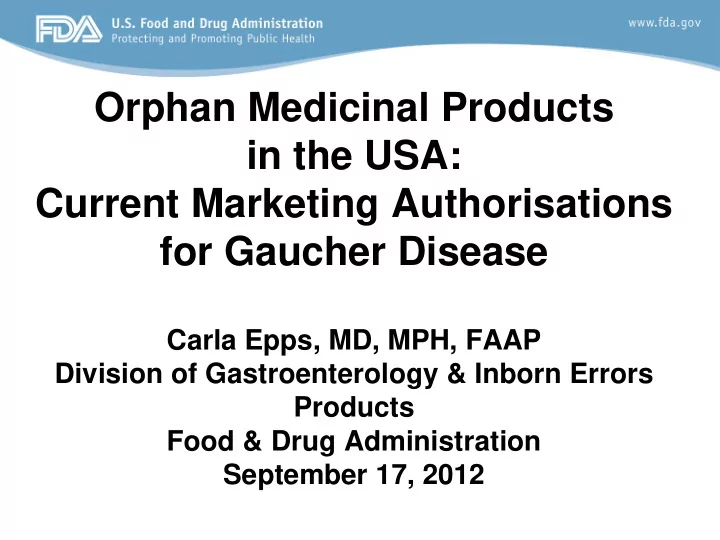

Orphan Medicinal Products in the USA: Current Marketing Authorisations for Gaucher Disease Carla Epps, MD, MPH, FAAP Division of Gastroenterology & Inborn Errors Products Food & Drug Administration September 17, 2012
Gaucher Orphan Product Designations • 14 orphan designations granted • 4 approved & currently marketed products – 3 enzyme replacement therapy (ERT) products – 1 substrate reduction therapy (SRT) product • No current active orphan product grants 2
Gaucher Products with Orphan Designation ERT SRT Pharmacological Other Products Products Chaperones •Alglucerase •L-cycloserine •Isofagamine •Alendronate •PEG- •Miglustat •Ambroxol glucocerebrosidase •Eliglustat •Recombinant glucocerebrosidase •Imiglucerase •Velaglucerase •Taliglucerase 3
US-Approved Products for Gaucher Disease Name Product Class Indication Ceredase (alglucerase)* ERT Gaucher Type 1 Cerezyme (imiglucerase) ERT Gaucher Type 1 VPRIV (velaglucerase alfa) ERT Gaucher Type 1 Elelyso (taliglucerase alfa) ERT Gaucher Type 1 (adults only) Zavesca (miglustat) SRT Gaucher Type 1 when ERT is not an option (adults only) *discontinued from market ERT= Enzyme Replacement Therapy SRT= Substrate Reduction Therapy
US-Approved Gaucher Products: Trial Design Product Population Design Endpoints Alglucerase Treatment-naïve OL, single arm, historical Change in (Ceredase) control hemoglobin, platelet count, liver, spleen Imiglucerase Treatment-naïve Randomized, DB, active Change in (Cerezyme) control (Ceredase) hemoglobin, platelet count, liver, spleen Miglustat Treatment-naïve 2 trials: both OL, single Change in (Zavesca) arm, historical control hemoglobin, platelet count, Patients not Randomized, OL, active liver, spleen receiving ERT control (Cerezyme), 3- arm 5
US-Approved Gaucher Products: Trial Design Product Population Design Study Endpoints Velaglucerase Treatment-naïve Randomized, DB, Change in (VPRIV) parallel dose hemoglobin, Treatment-naïve Randomized, DB, active platelet count, control (Cerezyme) liver, spleen ERT-treated OL, single-arm, patients historical control, switch from prior ERT Taliglucerase Treatment-naïve R, DB, parallel dose Change in (Elelyso) hemoglobin, ERT-treated OL, single-arm, platelet count, patients historical control, switch liver, spleen from prior ERT 6
Gaucher Trial Endpoints • Disease course is evolving with development of ERT and other therapies – Earlier ERT trials initially focused on biomarkers, hematologic and visceral organ endpoints – Elelyso trials used responder analyses of hematologic and visceral disease – Bone disease also assessed in some trials • State of art for assessing bone disease is evolving 7
US-Approved Gaucher Products: Indications • 5 products are approved; 4 products are still commercially available – 2 products indicated for pediatric use – No US products specifically indicated for treatment of neuronopathic Gaucher disease 8
Pediatric Labeling for Gaucher Products • Ceredase/Cerezyme “The safety and effectiveness [of Ceredase and Cerezyme] have been established in patients between 2 and 16 years of age . Use …in this age group is supported by evidence from adequate and well-controlled studies of [Ceredase and Cerezyme] in adults and pediatric patients, with additional data obtained from the medical literature and from longterm postmarketing experience.” • Zavesca “The safety and effectiveness of Zavesca in pediatric patients have not been established .” 9
Pediatric Labeling for Gaucher Products • VPRIV “The safety and effectiveness of VPRIV have been established in patients between 4 and 17 years of age . Use of VPRIV in this age group is supported by evidence from adequate and well-controlled studies of VPRIV in adults and pediatric [20 of 94 (21%)] patients.” • Elelyso “The safety and effectiveness of ELELYSO in pediatric patients have not been established . “ 10
US Pediatric Planning Process 11
Pediatric Clinical Development Issues • Limited number of pediatric patients available for enrollment • Trial design and study endpoints, especially for non-ERT products • PREA exemption for orphan products – implications for timing of development of pediatric plans • BPCA provides incentives for development – legislation now permanent under FDASIA 12
Recommend
More recommend